10 Email Marketing Mistakes You Need to Avoid for Better Deliverability
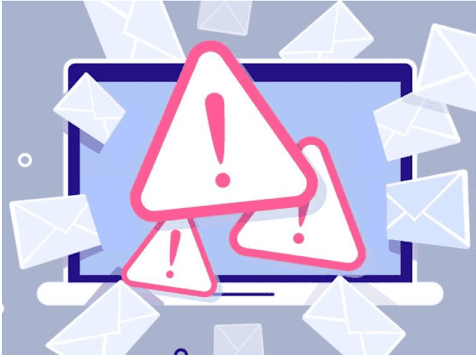
Did you know that roughly 45% of emails sent are considered Spam?
Yes, that number sounds bad.
Maybe your marketing emails aren’t spam, they can be treated as one by your recipient.
Note: This post was originally published in June 2015, and updated in November 2021 to include new tips and data.
For some people, email marketing is the best way to go, but others commit huge mistakes in their marketing emails and think that it doesn’t work.
So before you leave email marketing behind, why don’t you analyze your marketing emails first? Maybe there are things you can improve that you haven’t seen yet that’s why your efforts are failing miserably.
So, without further ado, here are the top 10 things you should stop doing in your marketing emails to increase open rates and conversions.
Generic subject lines
Serious question. How many emails do you receive every day? Maybe too much that you can’t read every single one of them.
According to TechJury, the average office worker receives around 120 emails per day.
What are the odds that your email will be one of the few opened? Or even just noticed?
Too low if your subject line is not as brilliant as Buzzfeed’s email subject lines.
![]()
Subject lines are one of the most crucial parts of an email, that’s why you have to be very careful when creating one.
Good thing there are ways you can follow to make sure that your emails will go directly to your recipients inbox—meaning higher chances of being opened!
- Avoid spammy words like “free,” “limited time,” “buy,” and using all caps, such as “REMINDER,” and “CLICK.”
- Be clear. Being witty or super creative with the subject line is fine, but be sure that you’re not compromising clarity. Be clear with your message and intention, and avoid disappointing your recipients by putting up a subject line that will not be further explained in the content.
- Be concise. Subject lines that work have 50 characters or fewer. Concise subject lines are recommended if you want it to be fully displayed in the email pane—especially for mobile devices.
A good subject line is not too generic that it doesn’t really speak with your recipients, rather, it should urge them to do something or show that they will benefit from reading your email.
Tip: A/B test your subject lines
A/B testing is when you change certain parts of your email, whether it be the subject line or body copy, to see how the changes impact your results.
By A/B testing, you get to see what works with your audience and what doesn’t. For example, if your subject lines with puns get consistently higher open rates, then moving forward you know it’s better to have punny subject lines.
Images that don’t display properly
We’ve all experienced receiving marketing emails with broken images.
I know… that’s frustrating.
Although you can’t always blame yourself or your email marketers for instances like this, because not all recipients can receive visual elements—some can only receive in plain text.
What you can do instead is to limit the usage of images, and make sure that you have proper alt text for all your images to keep your readers away from being clueless on what your images are all about.
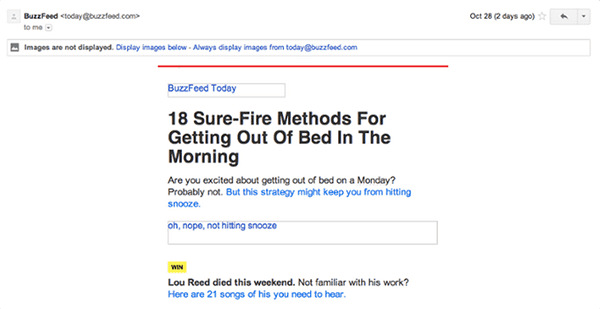
Usage of “no-reply” emails
Generic addresses, especially ‘no-reply’ ones prevent your readers from engaging with your business. And we don’t want that.
We want to receive emails with email addresses that we can reply to—where we can ask questions or give feedback.
‘No-reply’ email addresses have also been proven to decrease open rates, and increase unsubscribe and complaint rates.
If you’re not yet convinced that you should give up using ‘no-reply’ email, perhaps this guideline will finally persuade you.
The CAN-SPAM Act: A Compliance Guide for Business
According to the first item in the CAN-SPAM Act, “Your “From,” “To,” “Reply-To,” and routing information – including the originating domain name and email address – must be accurate and identify the person or business who initiated the message.”
Generic salutations
Personalization is a very important part of email creation. We give value and attention to emails that we know is made especially for us. And how do we know it’s for us?
When it’s addressed to us—when names are mentioned.
So stop that “To whom it may concern,” “Dear Sir,” or worse, “{INSERTFIRSTNAME}” salutation and start using actual names.
“…years and years of sifting through emails has conditioned people to discard anything that doesn’t come from a recognizable friend or family member and/or doesn’t open with a personalized greeting. Any message that doesn’t refer to the recipient by name is getting discarded—period—never to be pondered again. You have to be on a first-name basis with your recipient. That’ll get you in the door, so to speak, and leave the recipient open to reading your message.” -Dan Forootan (How Important Is Personalization To Your Email Marketing Campaign?)
If you’re using an email marketing software, check if you’re typing the correct personalization shortcodes. You wouldn’t want your subscriber to end up with a “Dear ,” or again, {INSERTFIRSTNAME}.
Misleading content in marketing emails
You promised something good in your subject line. Now you make sure that the content justifies it.
I’ve been subscribed to HubSpot for quite sometime now, and they never fail to keep their promises. When they say that a free guide or eBook is included, expect that a download link is included in that email—and expect that it’s really free.
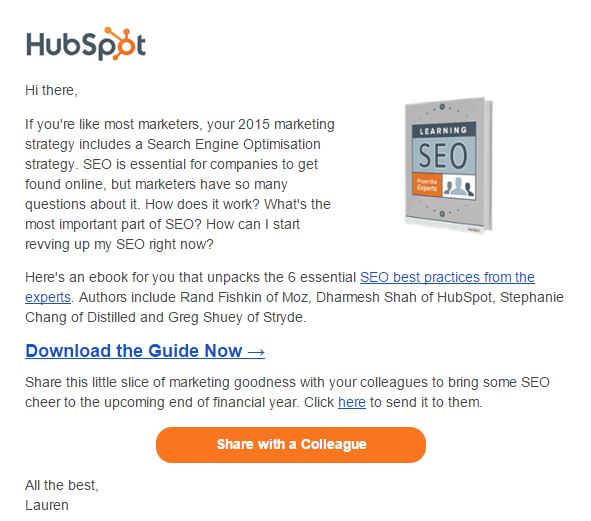
Just like the subject, avoid using spam trigger words like “prize,” “free,” “bonus,” “buy,” and “order.” Instead, use persuasive words like “because,” “you,” and “imagine.”
You can use HubSpot’s The Ultimate List of Email Spam Trigger Words to know what to avoid.
No call-to-action
Unless you’re doing a personal email and just want to say hi, you need a call-to-action.
The very reason why you’re marketing through email is because you want to sell something, or perhaps you want your readers to benefit from you. The point is you either want to give, or you need something—usually both.
Make your intentions clear by putting call-to-action. And guide your audience on what to do—until the very last step.
“Be clear and direct with your users, telling them exactly what you’d like them to do.” –Conversion Rate Experts
Including a short explanation or bullets of your product’s features with call-to-action button is also a good way to convert.
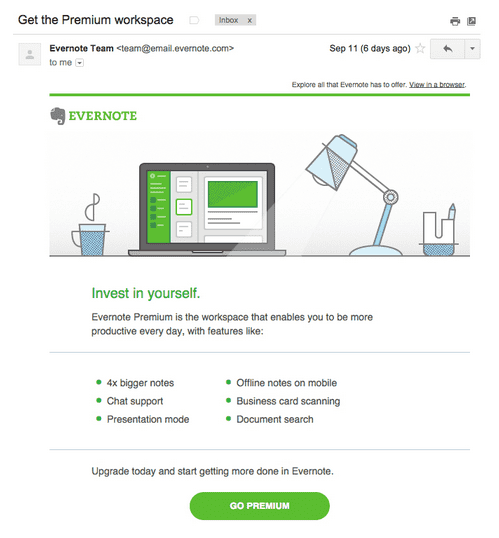
Multiple marketing emails with the same content
Weeks ago, I committed a mistake that nobody should ever follow.
I published a post in SEO Hacker, and later on decided to modify the headline and slugs. There’s nothing wrong with that—you can always change your title and slugs if you feel that it’s necessary to do so. However, when your published post is automatically being sent to thousands of subscribers, then you have to be careful.
I use an email marketing software called AWeber, and every time we publish an article, it automatically sends an update to our subscribers like this:
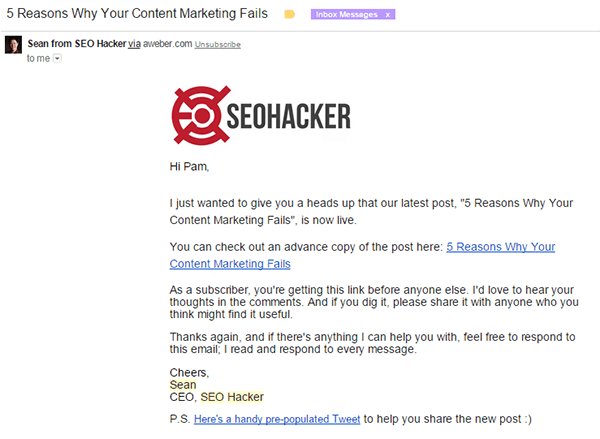
Once it’s sent, and you modified the slugs of your post, it will generate a new email—regardless if it’s the same post or not. That’s what I did, and that’s the dangerous part.
Just by modifying the slugs, I have sent two emails (in the same day) containing two different titles but the same content and is directed to the same article.
![]()
Not a very nice move!
It can confuse your readers, or they may not give importance to your emails at all, because really, who wants to be bombarded with multiple emails with the same content?
No option to unsubscribe from marketing emails
Admit it, even if you have compelling content, there will always be people who won’t like (or will stop liking) receiving marketing emails. That’s why you need to give them the option to unsubscribe – and make it visible.
A while back, Gmail started displaying the unsubscribe links at the top of messages.

But you should still include an ‘unsubscribe’ button. For example, my Leadership Stack Podcast emails have this option at the footer.
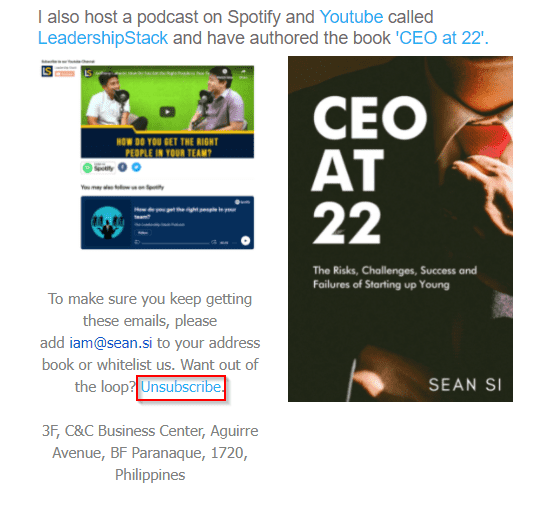
Not segmenting the customers for marketing emails
Another major mistake that you may be committing is forgetting to segment your customers. Customer segmentation is the process of grouping customers based on various factors such as age, gender, industry, and others.
It’s important to ensure your customers are segmented properly so that the emails they get are personalized. For example, some of my customers work in marketing, some work in SEO, and others are entrepreneurs. If the emails they get don’t fit their demographic, they would just unsubscribe because I’m not adding value to their life.
Besides, receiving the kind of content everyone else receives doesn’t feel good. As a customer, you want to be spoken to. Segmenting customers helps with that.
Having generic content
I already touched on it a little earlier: Having generic content doesn’t do anyone any favors. Your customers don’t want to receive the same content as everyone else. They want you to speak to them.
Let’s say you’re asking for a donation, and you’re just asking the same amount from everyone. What if a third of the people you sent that email to are living paycheck-to-paycheck, the other third are living comfortably, and the final third are rich? Expecting all of them to give $50 will be unreasonable, and your email will show them that you don’t care about their situation.
You can avoid that by personalizing your email using dynamic content, where certain parts of your email are filled in by the data your customers provide you. This makes the email – you guessed it – personal for the customer. According to Keela, “When compared to non-personalized email campaigns, personalized emails yield 29% higher unique open rates and 41% unique click rates.”
Key takeaway
Sometimes we get so excited, we want to jump right in and just do things for marketing’s sake, leaving no chance for proper planning and execution.
But, that’s not how it should be – even in email marketing.
Once in a while, you need to do an audit of your email marketing. Ask yourself, “How is it working for me?” and “What are the things I need to improve?” Then you can try different styles, different approaches, perhaps different tones, but never ever commit these 10 email marketing sins. Unless you want to end up in the spam folder of your recipients.
And of course, if you want to be absolutely sure that these 10 deadly sins won’t be committed, we have an email marketing service you can check out.
Happy email marketing, and let me know what you think!